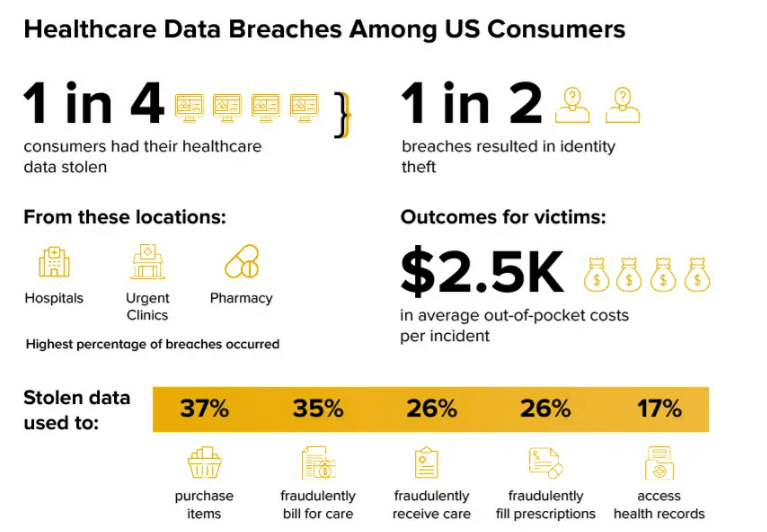Data is the most confidential information that needs to be protected irrespective of the domain or industry to which it belongs. And healthcare corresponding organizations are one of the many industries that are falling victim to extensive data breach scenarios at a startling amount.
One of the recent cases of this data breach was the 2022 incident at Yuma Regional Medical Center– the ransomware attack that exposed the data of over 700,000 patients. And the count of such data breaching cases is growing. Look at the graph below to thoroughly understand the layout:

The above graph clearly shows that the numbers are vigorously increasing on a year-on-year basis. Due to this scalability, many healthcare organizations are turning to software development services to build an unbreachable data-secured tool for the seamless transmitting and storing of medical reports and information.
Here the role of HIIPA (Health Insurance Portability and Accountability Act of 1996) Compliance comes into the picture to ensure the soundness and security of the developed healthcare software.
Hence, the major focus is on HIIPA-compliant software testing. Now you must be wondering what if you do not imply the healthcare software with HIIPA-compliance testing? You can fall into the trap of cybercrime with data leaks and illegal usage. Furthermore to this, it may also lead to severe punishments from the US Department of Health & Human Services department.
For this reason, your healthcare software development team must devote effort to creating a HIPAA-compliant application with a stronger emphasis on software testing.
As a healthcare software development company, DianApps has designed, tested, and deployed healthcare apps affecting several stakeholders without ever experiencing a breach.
In this blog, we will discuss the various ways of identifying HIPPA compliance in your healthcare application via using the technique of software testing. But let’s first examine why it’s getting more and more challenging to create HIPAA-compliant software.
Why is building HIPAA-compliant software difficult?
Building HIPAA-compliant software can be difficult for several reasons:
Complex regulatory requirements:
The Health Insurance Portability and Accountability Act (HIPAA) is a federal law that sets standards for the privacy, security, and confidentiality of protected health information (PHI). HIPAA regulations are complex, and understanding them can be challenging.
Technical challenges:
HIPAA requires that software developers implement specific technical safeguards to protect PHI, including encryption, secure access controls, and regular backups. Implementing these technical requirements can be challenging and time-consuming, especially for smaller development teams.
Ongoing maintenance and updates:
HIPAA regulations are constantly evolving, and software developers must stay up-to-date with the latest changes to maintain compliance. This can require significant ongoing investment in time and resources.
Cost:
Building HIPAA-compliant software can be expensive due to the need for specialized expertise and technology. Software developers must invest in security and compliance features, and often need to hire outside consultants to ensure that their software is fully compliant.
Liability:
If software developer fails to meet HIPAA compliance requirements, they may face significant legal and financial consequences. This can be a significant risk for software developers, especially if they are handling sensitive PHI on behalf of healthcare providers or other organizations.
What Strategies to adopt for HIPAA software testing?
When testing software for compliance with HIPAA regulations, it’s important to consider both functional and non-functional testing strategies. Here are some areas to focus on when testing for HIPAA compliance:
Access Control:
Test the software’s ability to authenticate and authorize users. Verify that only authorized individuals can access PHI and that the software includes appropriate access control features such as role-based access, two-factor authentication, and audit trails.
Encryption:
Test the software’s ability to encrypt PHI in transit and at rest. Verify that all communications between the software and other systems are encrypted and that PHI stored within the software is properly encrypted.
Audit Logging:
Test the software’s ability to log and track all activities related to PHI. Verify that audit logs capture relevant information such as user actions, access attempts, and data modifications, and that they are protected from unauthorized access.
Disaster Recovery:
Test the software’s ability to recover from data loss and system failures. Verify that data backups are created regularly and that they can be easily restored in the event of a disaster.
Vulnerability Management:
Test the software’s ability to identify and remediate vulnerabilities. Verify that the software is regularly tested for vulnerabilities, and that identified vulnerabilities are remediated promptly.
Business Associate Agreements:
Test the software’s ability to support HIPAA-compliant business associate agreements. Verify that the software includes appropriate provisions for business associate agreements and that these agreements are established and maintained with any third-party service providers.
Training and Awareness:
Test the software’s ability to support training and awareness for staff. Verify that the software includes features to support staff training and awareness, and that staff is regularly trained on HIPAA compliance requirements.
By testing these areas thoroughly, mobile app developers can help ensure that their software is fully compliant with HIPAA regulations and can protect sensitive PHI from unauthorized access or disclosure.
Steps to achieve and maintain HIPAA compliance in software testing
Achieving and maintaining HIPAA compliance in software testing requires a multi-step approach. Here are some key steps that software developers should follow to achieve and maintain HIPAA compliance:
Conduct a HIPAA Risk Analysis:
A risk analysis helps identify potential threats and vulnerabilities to the confidentiality, integrity, and availability of PHI. Software developers should conduct a risk analysis before developing or updating their software to identify potential areas of risk and develop a plan to mitigate those risks.
Develop Policies and Procedures:
Software developers should develop policies and procedures that are specific to HIPAA compliance. This includes policies related to access control, data backup and recovery, encryption, and incident response.
Train Staff:
All staff involved in the development and testing of the software should receive regular training on HIPAA compliance requirements. This includes training on how to handle PHI, how to report incidents, and how to follow the organization’s policies and procedures.
Implement Technical Safeguards:
Software developers should implement technical safeguards to protect PHI. This includes encryption, access controls, audit logging, and data backup and recovery.
Test the Software for Compliance:
Software developers should test their software to ensure that it meets HIPAA compliance requirements. This includes functional testing to ensure that the software is working as intended, as well as non-functional testing to ensure that it meets HIPAA requirements related to security, privacy, and confidentiality.
Establish and Maintain Business Associate Agreements:
If the software is used by covered entities and business associates, software developers should establish and maintain business associate agreements that include appropriate HIPAA compliance provisions.
Monitor and Maintain Compliance:
Software developers should monitor and maintain compliance with HIPAA requirements on an ongoing basis. This includes regularly reviewing and updating policies and procedures, monitoring access logs, and conducting regular risk analyses.
By following these steps, software app developers can achieve and maintain HIPAA compliance in their software testing efforts. It’s important to note that HIPAA compliance is an ongoing process, and software developers must remain vigilant and make regular updates to their software to ensure ongoing compliance with HIPAA regulations.
Process DianApps follow for HIPAA compliance testing
When testing software for HIPAA compliance, our software app developers make sure to follow the process that involves the following steps:
Identifying the scope of the testing:
Determine which components of the software will be tested and which HIPAA requirements will be covered.
Develop Test Scenarios:
Develop test scenarios that cover the various HIPAA requirements. These scenarios should be designed to validate that the software is compliant with HIPAA regulations.
Execute Test Cases:
Execute the test cases and document the results. Record any deviations from expected results, and identify any areas where the software is not compliant with HIPAA requirements.
Analyze the Test Results:
Analyze the test results to identify any patterns or trends. Identify any areas where the software is not compliant with HIPAA requirements, and prioritize these areas based on the level of risk they pose.
Remediate Non-Compliant Areas:
Remediate any non-compliant areas identified in the testing. This may involve modifying the software, updating policies and procedures, or providing additional staff training.
Re-Test:
Re-test the software to ensure that the remediated areas are now compliant with HIPAA requirements.
Document the Testing:
Document the testing process, including the test scenarios, test cases, and test results. This documentation can be used to demonstrate compliance with HIPAA requirements.
Regularly Review and Update the Testing Process:
Regularly review and update the testing process to ensure that it remains up-to-date with changes to HIPAA regulations and the software itself.
By following this process, we ensure that our software is compliant with HIPAA requirements and that they have documented evidence of their compliance efforts. It’s important to note that testing for HIPAA compliance is an ongoing process, and our skilled software developers regularly review and update their testing process to ensure ongoing compliance.
Factors that Impact the cost of HIPAA compliance testing
The cost of HIPAA compliance testing can vary depending on various factors, such as the size and complexity of the software, the level of testing required, and the testing methodology used. Here are some factors that can impact the cost of HIPAA compliance testing:
Type of Testing:
The cost of HIPAA compliance testing will depend on the type of testing required. Functional testing, which verifies that the software works as intended, may be less expensive than non-functional testing, which focuses on security, privacy, and other compliance-related requirements.
Testing Tools:
The cost of HIPAA compliance testing will also depend on the testing tools used. Automated testing tools may be more expensive than manual testing, but they may also be more efficient and provide better coverage.
Test Environment:
The cost of HIPAA compliance testing may also depend on the test environment used. Setting up a test environment that mimics the production environment may be more expensive than testing in a simulated environment.
Testing Team:
The cost of HIPAA compliance testing will depend on the size and expertise of the testing team. Hiring external consultants or security experts may be more expensive than relying on an internal team.
Timeframe:
The cost of HIPAA compliance testing will also depend on the timeframe required to complete the testing. Rushed testing may require more resources and may be more expensive than a more extended testing timeframe.
It’s difficult to provide an exact cost for HIPAA compliance testing as it varies based on the above factors. However, the cost of HIPAA compliance testing is an essential investment to ensure that the software meets HIPAA requirements and protects sensitive patient data.
Ultimately, the cost of HIPAA compliance testing is likely to be much lower than the cost of a HIPAA breach, which can result in significant financial penalties, reputational damage, and loss of patient trust.
Conclusion
All-in-all, this article covers major HIPAA compliance software testing areas stating key strategies, steps, and processes along with the cost bifurcations. Therefore, if you are in a healthcare business and want your data to be in a secure environment, building software is critical that includes HIPAA compliance software testing for the betterment and trust of your patients.
Reach out to us in case you need assistance in healthcare app development services or want to create a more secure platform for your existing application.










Leave a Comment
Your email address will not be published. Required fields are marked *